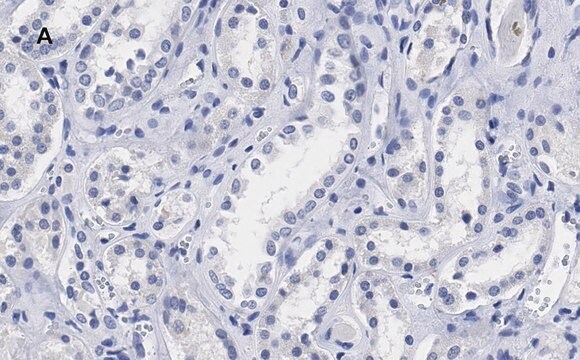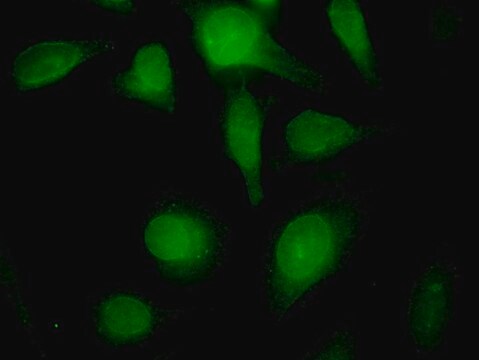推荐产品
生物源
rabbit
共軛
unconjugated
抗體表格
affinity isolated antibody
抗體產品種類
primary antibodies
無性繁殖
polyclonal
產品線
Prestige Antibodies® Powered by Atlas Antibodies
形狀
buffered aqueous glycerol solution
物種活性
human
技術
immunoblotting: 0.04-0.4 μg/mL
immunofluorescence: 0.25-2 μg/mL
immunohistochemistry: 1:20-1:50
免疫原序列
LCTKNLEHPIQWLYITCRKVCKGAEKPVPPRLLTEEEYRIQGEVETRKALEELREFCNSPDCSAWKTVSRIQSPKRFADFVEGSSHLTPNEVSVHEQEYGLGSIIAQDEIYEEASSEEEDSYSRCPAITQNNF
運輸包裝
wet ice
儲存溫度
−20°C
目標翻譯後修改
unmodified
基因資訊
human ... TMEM194A(23306)
一般說明
The gene TMEM194A (transmembrane protein 194A), also referred to as NEMP1 (nuclear envelope integral membrane protein 1), is an inner nuclear membrane protein 1. The encoded protein has two regions A and B with evolutionarily conserved sequences in the transmembrane domains (TMs) and the C-terminal region. It is found to be expressed in the Xenopus anterior neuroectoderm at the neurula stage.
免疫原
nuclear envelope integral membrane protein 1
應用
All Prestige Antibodies Powered by Atlas Antibodies are developed and validated by the Human Protein Atlas (HPA) project and as a result, are supported by the most extensive characterization in the industry.
The Human Protein Atlas project can be subdivided into three efforts: Human Tissue Atlas, Cancer Atlas, and Human Cell Atlas. The antibodies that have been generated in support of the Tissue and Cancer Atlas projects have been tested by immunohistochemistry against hundreds of normal and disease tissues and through the recent efforts of the Human Cell Atlas project, many have been characterized by immunofluorescence to map the human proteome not only at the tissue level but now at the subcellular level. These images and the collection of this vast data set can be viewed on the Human Protein Atlas (HPA) site by clicking on the Image Gallery link. We also provide Prestige Antibodies® protocols and other useful information.
The Human Protein Atlas project can be subdivided into three efforts: Human Tissue Atlas, Cancer Atlas, and Human Cell Atlas. The antibodies that have been generated in support of the Tissue and Cancer Atlas projects have been tested by immunohistochemistry against hundreds of normal and disease tissues and through the recent efforts of the Human Cell Atlas project, many have been characterized by immunofluorescence to map the human proteome not only at the tissue level but now at the subcellular level. These images and the collection of this vast data set can be viewed on the Human Protein Atlas (HPA) site by clicking on the Image Gallery link. We also provide Prestige Antibodies® protocols and other useful information.
生化/生理作用
The gene TMEM194A (transmembrane protein 194A) was first identified to participate in the eye development of Xenopus. The protein is found to interact with itself via the TMs and with lamin via region A. The localization of this protein to the inner nuclear membrane is mediated by its interaction with lamin. The region B of this protein is found to associate with the small GTPase Ran. TMEM194A may also be involved in the accumulation of RanGTP at the nuclear periphery. Knock-down of both tmem194A and ran is found to cause a decrease in cell densities and severe eye defects in Xenopus. TMEM194A is co-expressed with baf (barrier-to-autointegration factor) in the eye anlagen, and together they regulate the expression of eye marker genes.
特點和優勢
Prestige Antibodies® are highly characterized and extensively validated antibodies with the added benefit of all available characterization data for each target being accessible via the Human Protein Atlas portal linked just below the product name at the top of this page. The uniqueness and low cross-reactivity of the Prestige Antibodies® to other proteins are due to a thorough selection of antigen regions, affinity purification, and stringent selection. Prestige antigen controls are available for every corresponding Prestige Antibody and can be found in the linkage section.
Every Prestige Antibody is tested in the following ways:
Every Prestige Antibody is tested in the following ways:
- IHC tissue array of 44 normal human tissues and 20 of the most common cancer type tissues.
- Protein array of 364 human recombinant protein fragments.
聯結
Corresponding Antigen APREST73155
外觀
Solution in phosphate-buffered saline, pH 7.2, containing 40% glycerol and 0.02% sodium azide
法律資訊
Prestige Antibodies is a registered trademark of Merck KGaA, Darmstadt, Germany
免責聲明
Unless otherwise stated in our catalog or other company documentation accompanying the product(s), our products are intended for research use only and are not to be used for any other purpose, which includes but is not limited to, unauthorized commercial uses, in vitro diagnostic uses, ex vivo or in vivo therapeutic uses or any type of consumption or application to humans or animals.
未找到合适的产品?
试试我们的产品选型工具.
儲存類別代碼
10 - Combustible liquids
水污染物質分類(WGK)
WGK 1
閃點(°F)
Not applicable
閃點(°C)
Not applicable
個人防護裝備
Eyeshields, Gloves, multi-purpose combination respirator cartridge (US)
Hiroshi Mamada et al.
Developmental biology, 327(2), 497-507 (2009-01-27)
To clarify the molecular mechanisms of neural development in vertebrates, we analyzed a novel gene, termed nemp1 (nuclear envelope integral membrane protein 1), which is expressed in the Xenopus anterior neuroectoderm at the neurula stage. Nemp1 has a putative signal
Takashi Shibano et al.
PloS one, 10(5), e0127271-e0127271 (2015-05-07)
The inner nuclear membrane (INM) protein Nemp1/TMEM194A has previously been suggested to be involved in eye development in Xenopus, and contains two evolutionarily conserved sequences in the transmembrane domains (TMs) and the C-terminal region, named region A and region B
我们的科学家团队拥有各种研究领域经验,包括生命科学、材料科学、化学合成、色谱、分析及许多其他领域.
联系技术服务部门








